
First – Some short Thunderbean news:
The Rainbow Parades V1 set is quickly rounding the corner from *being in progress forever’ to ‘off to replication’. We’re getting closer on finishing the animated titles, and I’m finally at a point where I can actually sit down and finish animating my own parts. I’m looking at ways to get the duplication of special sets down faster (with one BDR duplicator stepping in to help) and shipping is now almost entirely being taken over by my small staff.

I was thinking about the various ‘home movie’ distributors of cartoons over the years and their influence on the things we’ve been able to see- and the ones I was able to see, and thought it might be fun to put together a list of some of the companies that released films for home use. Some of these catered directly to collectors, some licensed things from various studios, and some just distributed things that were (as far as they knew) in the public domain. I’ve talked about some of these companies here and there in the past, but here’s a sort of ‘short list’ = part 1- of ones that you’ll likely find if you’ve been collecting film or video over the years. All of these are notable in that they released classic animation over the years. Let’s dig in:
Castle Films: Castle films is, in my mind, one of the kings of home movie and non-theatrical release of classic animation on 8mm and 16mm. The company, started by Eugene Castle, distributed 8mm and 16mm films for home use starting in the early 30s. They made deals with many big and small distributors over the years, most notably Universal, who bought the company in the late 40s. They’re one of the most fun to collect in that there’s lots of titles, colorful boxes and some really good prints. Classic animation titles they released include cartoons from the Lantz studio, Terrytoons and Ub Iwerks.
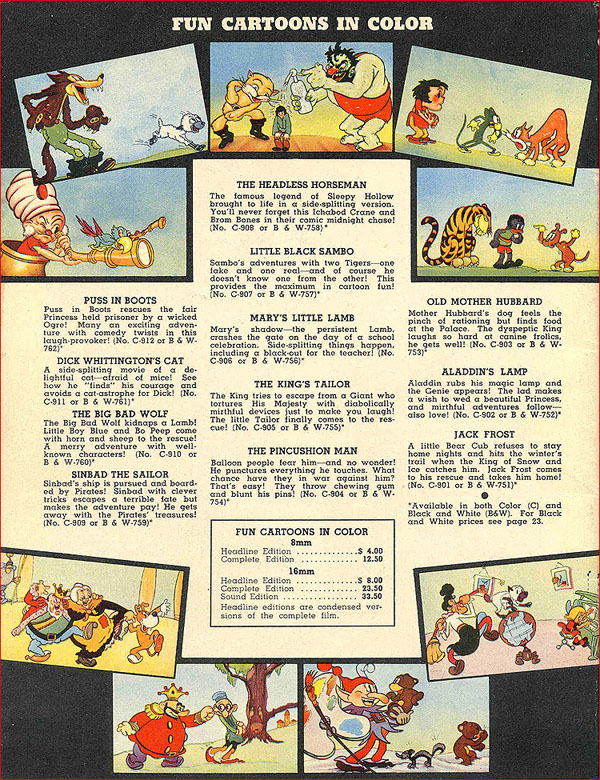
Official Films is the second largest of the distributors of 8mm and 16mm Home Movie versions of films from 1939 through the mid-60s. The company’s name, ‘Official Films’ stems from being the ‘Official’ company to distribute films about the 1939 World’s Fair. One the years, they distributed cartoons from all sorts of studios, including a pretty good chunk of the Van Beuren cartoons, some Iwerks’ Flip the Frog cartoons, independent animated shorts including Ted Eshbaugh’s ‘The Snowman’ Capn’ Cub and ‘Goofy Goat Antics’. Official later released a lot of their licensed films to Televison, eventually becoming more active in TV distribution. Select Film Library attained some of Official’s negatives in later years, releasing them on 8mm and 16mm into the 60s.

Pictoreels is a really interesting little company. They’re especially of note because of their distribution of Harman-Ising cartoons from the 30s, in both Black and White and Kodachrome. Cartoonist Mark Kausler noted that Hugh Harman had a litigation battle with MGM for years about the sale of their films to Pictoreels, but, oddly enough, they kept selling them for many years. Pictoreels also distributed Harman’s Winky the Watchman, and black and white and color versions of some of George Pal’s early Puppetoons.
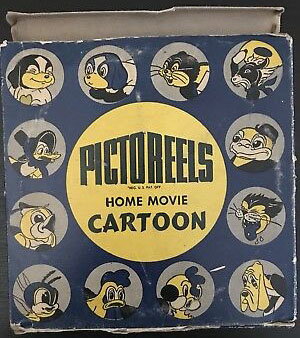
Hollywood Film Enterprises was a small company that was the exclusive distributor of home movie versions of Disney cartoons through 1950. They distributed a few other series of cartoons as well- notably the three ‘Gran’ Pop’ Monkey Cartoons from Cartoon Films, Limited.
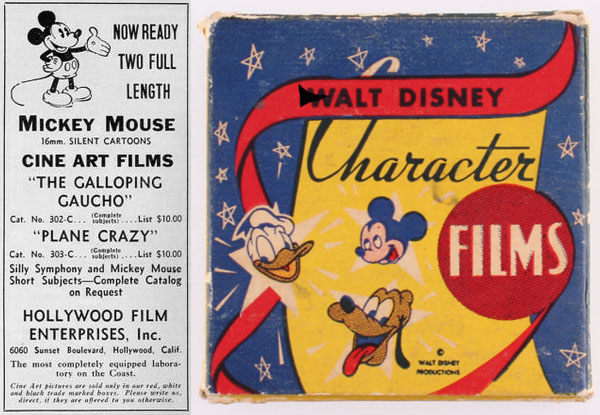
Exclusive Movies distributed short home movie versions of Fleischer Cartoons (Betty Boop and Popeye) in the 30s as well as lots of different silent series, including Krazy Kat and a lot of rare stop motion shorts from the 20s. This small company was started right at the beginning of 16mm as a format and seems to have folded sometime in the late 40s. Without them, some entries in early series of animated films may have been lost.
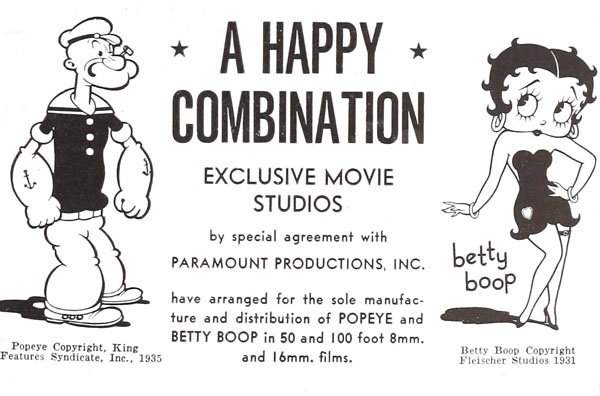
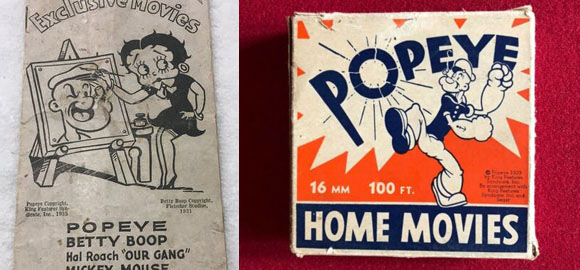
Keystone Films, a division of the Keystone Camera Company in Boston, released quite a few rare silent films in 8mm and 16mm through the mid-40s, including Jerry on the Job shorts, US Fellers, Krazy Kat and Mutt and Jeff Cartoons..Keystone’s boxes from the 30s are especially cool and fun collectables. I would love to have seen a display of these films next to Keystone’s Camera’s projectors and cameras.
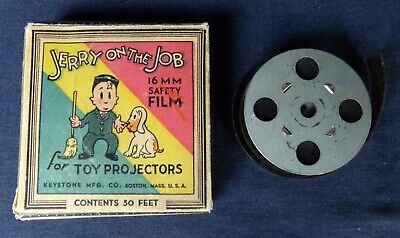
Excel Home Movies distributed silent home movie versions in 16mm of Columbia’s Krazy Kat, Scrappy and Barney Google cartoons. Excel also seems to have distributed quite a few silent shorts.

This ad is especially fun, showing one of Excel’s little ‘Toy’ projectors from the late 30s.
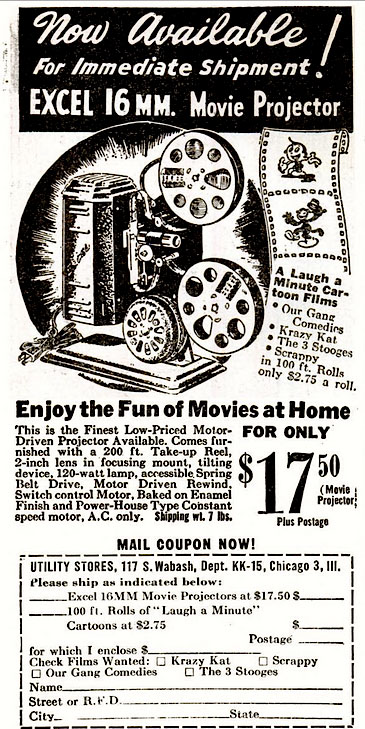
Canterbury Films, named after the street it was started on, was a small company run by Les Brooks in the 70s into the 80s. They distributed public domain films from various studios on super 8mm and 16mm, including some of the Fleischer Color Classics and even the feature Gulliver’s Travels. Les’ prints were generally pretty good, and some of the first super 8 prints of cartoons I bought myself. I’m not sure if Les still runs his company ‘Mice, Ducks and Wabbits’ that specialized in original animation art. I was greatly inspired by this small company, and some of the other small super 8mm and 16mm distributors.

Thunderbird Films. Thunderbird films has no relation to Thunderbean, although similar in name (The Thunderbean name actually has its origins in a puppet character my brother and I came up with in the 70s. We eventually named one of our cats Thunderbean as well- before I had heard of Thunderbird films). Thunderbird was run by Tom Dunnahoo, a real character who distributed films in super 8mm and 16mm. I’ve heard that Thunderbird went out of business in the late 70s, although I managed to get a catalog in the early 80s from them; I have to wonder if the company by that point was still operating but not being run by Dunnahoo. They distributed a lot of public domain animation, including Fleischer cartoons and shorts from Van Beuren and really anything else they managed to make a print of. I’m sure there’s folks here who have stories about Thunderbird.

Red Fox Films was another small company that released films in super 8mm and 16mm. They were, I think, the second catalog I ever got, and I pined for some of the cartoons they had listed! Later I would borrow ‘Mr. Bug (Happily) Goes to Town’ on super 8 from the local library here, and their print was pretty good, coming from a 35mm Ib tech print!

I’ll continue the list in the coming weeks – there’s many more to note! Have a good week everyone!


 Steve Stanchfield is an animator, educator and film archivist. He runs Thunderbean Animation, an animation studio in Ann Arbor, Michigan and has compiled over a dozen archival animation DVD collections devoted to such subjects at Private Snafu, The Little King and the infamous Cubby Bear. Steve is also a professor at the College for Creative Studies in Detroit.
Steve Stanchfield is an animator, educator and film archivist. He runs Thunderbean Animation, an animation studio in Ann Arbor, Michigan and has compiled over a dozen archival animation DVD collections devoted to such subjects at Private Snafu, The Little King and the infamous Cubby Bear. Steve is also a professor at the College for Creative Studies in Detroit.






















FYI: Exclusive and Excel were the same company.
Thanks for explaining the origin of the Thunderbean name. I always assumed it was a flatulence joke.
Some of those Popeye abridgements originally released by Exclusive were still available in the 1970s from Ken Films in both standard and super 8mm.
https://cartoonresearch.com/wp-content/uploads/2020/06/six-excel-16mm-movies.jpg
My new wallpaper! Thanks so much!
Interesting. Castle Films were the only ones mentioned here widely available in the UK. I had a couple of ‘Headline’ fifty-footers, all my allowance would allow me!
as a film collector since the 60s, this is a great [and happy] little arena to “explore” and revisit!! Terriff!!
Steve:
Select Films and/or Official Films – I think – still put stuff out in the early ’80s – on Super 8 and 16mm. I think Thunderbird Films was still going into the early ’80s as well because I bought a decent Super 8mm print of WHITE ZOMBIE from them, that was pretty decent. Frank Storace – of Storace Films – told me that the major movie studios – including independent producer Sherman Krellberg – were out to “get” Thunderbird Films for all the film pirating they had been involved with over the years!
Blackhawk Films and Niles Films sold some cartoons – I seem to remember that Niles had BLACK-AND-WHITE prints of POPEYE cartoons like SINDBAD and ALI BABA for sale! Niles’ stuff was either “hit or miss.” I bought a print of ROCKETSHIP (1936) – A studio made feature version of FLASH GORDON – and the quality was so crummy, I tried to send it back, but the company claimed that was the “best that was available”! Yeah, right! Blackhawk Films – as you know – had pretty good prints of the Ub Iwerks cartoons – through buying some (or all?) of the Commonwealth Film library – which I think Dave Shepard was responsible for?
I’d like to hear what you have got to say about little companies like Atlas, Carnival Films, etc. – they seemed to grab chunks of films with new titles, and you never knew what you were going to get! Great article, keep it up!
I have heard about, and maybe have seen a quick example of the first black and white TV prints of pre 1948 COLOR WB cartoons. I could have sworn somewhere on streaming video that there were old B/W copies of otherwise color Warner Cartoons
with the Technicolor reference “brick walled” out as the shield zooms up.
Was I hallucinating or were the first 16mm TV copies of those cartoons originally distributed to local stations that way?
Any answer would be welcome
-Chris
I have a few of those B&W aap TV prints of color Warner Brothers cartoons. The end title was a spliced-in freeze frame of “That’s All Folks”, no mention of Warner Brothers. The opening went directly from the aap logo with the cartoon characters ad then jumped directly to the “Merrie Melodies” credit, no WB shield.
A few of the color prints sent to TV stations through the 1980’s, like Conrad The Sailor, were still formatted this way.
Which distrubutors did the blue track ib tech films with theatrical titles? Just curious?
I’ll defer to Steve – but I think the 16mm Walter Lantz blue track Tech prints with original titles were NOT distributed or sold as home movies to the public. I think those surviving prints were made up for the non-theatrical rental libraries – and for military (Army-Navy) use.
Castle Films sold their first Walter Lantz color cartoons in Blue-Track Technicolor, their catalogues from the early 1950’s specifically mention these are Technicolor Prints. Because it was too expensive to modify the Technicolor printing matrixes, these prints retained their original Universal theatrical titles.
These were generally too expensive for home movie collectors, so when Eastancolor was developed in 1952, Castle Films switched to that more affordable (and unstable) color format with Castle’s name back in the titles. Generally the titles were edited slightly to cut out any mention of Technicolor.
I worked for Tom Dunnahoo the summer of 1979 before I started at USC. He was operating out of a big frame house on Harvard Street off Wilshire Boulevard, near where I was living. I ran off mostly the black and white prints. He was also getting into some of the first Home Video transfers, too. About a year later he went to jail. That’s all I’ll report on that.
According to Scott MacGillivray’s wonderful book on Castle Films (pgs, 205-207), they DID issue real IB prints of 1940s Lantz cartoons from 1949-1951. Titles were: Boogie Woogie Sioux, Cow Cow Boogie, Swing Your Partner, The Greatest Man In Siam, Jungle Jive, Boogie Woogie Man, Woody Dines Out, The Loose Nut, and The Dippy Diplomat. Then they went to other color processes using Kodachrome, Ansco and Eastman color stocks. The Kodachromes and Ansco color prints hold up pretty well.
Also what about Nu-Art Firelight films? They put out Flip the Frogs in regular 8mm, at least.
Fireside Films. I’ve been looking for their version of their sole advertised silent cartoon reissue, Koko the Convict, for years. I think there was a TV distributor called Firelight. I seem to recall seeing a VHS transfer of a sound Lantz Oswald (maybe a reissue of Guild product, or a separate licensee) with their titles.
That’s amazing that Castle Films put out IB Technicolor prints. I never knew that. I assume that Castle’s Lantz cartoons didn’t feature the original Universal theatrical titles. I’d love to see the Castle Films logo in Tech.
I got a super-8 mag sound copy of Popeye/Sindbad from Thunderbird in the early 70s. I recall it being sharp but magenta-ish. One of those titles that was, ahem, “assumed” to be PD in the super-8 sound boomlet that lasted a handful of years then petered out when home VCRs started proliferating among collectors. Like me.
They didn’t put the Castle Films logo on the IB prints, they were blue track prints with the Universal logos. Castle didn’t make their own negatives until they started releasing in Kodachrome after 1951. If you look at the list of IB Castle titles I provided, you will note that they are the more common Lantz titles from the 1940s that show up in IB prints.
My friend James Tucker sent me this notice in the Castle Films catalog mentioning the Technicolor prints – and a few frames from his blue-track Swing Symphonies print.
Pictoreels (Pictorial Films) was a division of Pathe Industries (Laboratories,) which owned the PRC/Eagle-Lion studio. Pictorial sold PRC features to rental libraries. Hollywood Film Enterprises was primarily a lab, the descendant of the old Bill Horsley laboratory. They had 8mm prints of the Disney cartoons into the 60’s, including some in Eastmancolor, as well as color travelogues of Disneyland. I suspect when Disney was preparing to enter the 8mm business themselves, they pulled HFE’s license; and whatever they had left (a handful of Laurel & Hardy reels, some silent-era Tarzan films, etc.) was not enough to sustain their home movie business. They continued as a lab for many years afterward.
Great to see the information on home movies! The only brands I saw in local stores in the Chicago area in the 60’s were Castle Films, Ken Films, and much later Walt Disney Home Movies. 50 foot Carnival Films were available in dime stores for under a dollar. Those could be very poor quality.
Tom Dunahoo, what a scumbag. Not only was he a known pirate [and proud of it] and illegally sold bootlegged copyrighted [and at the time current!] films but he was also a damned pedophile, read the details online and you may wish to take a long shower afterwards. I’ll tell you, the film collecting world has brought out some strange individuals, but none more revolting than Dunahoo.
I got into 8mm around 1972, when I discovered Blackhawk Films. PREVUE 8 was my first purchase. When I graduated college in 1981, I moved into Super 8 sound. Red Fox and Canterbury were two of my favorites!!
Tom Dunahoo even planned on releasing a theatrical feature compilation of STAR TREK episodes! He was already skating on thin ice offering them for non-theatrical use.
The Star Trek TV series was a copyright gray area until 1976 when Paramount TV finally copyrighted the show. The original producer, Desilu, was in financial trouble with the Star Trek production costs that they never finalized the copyright process.